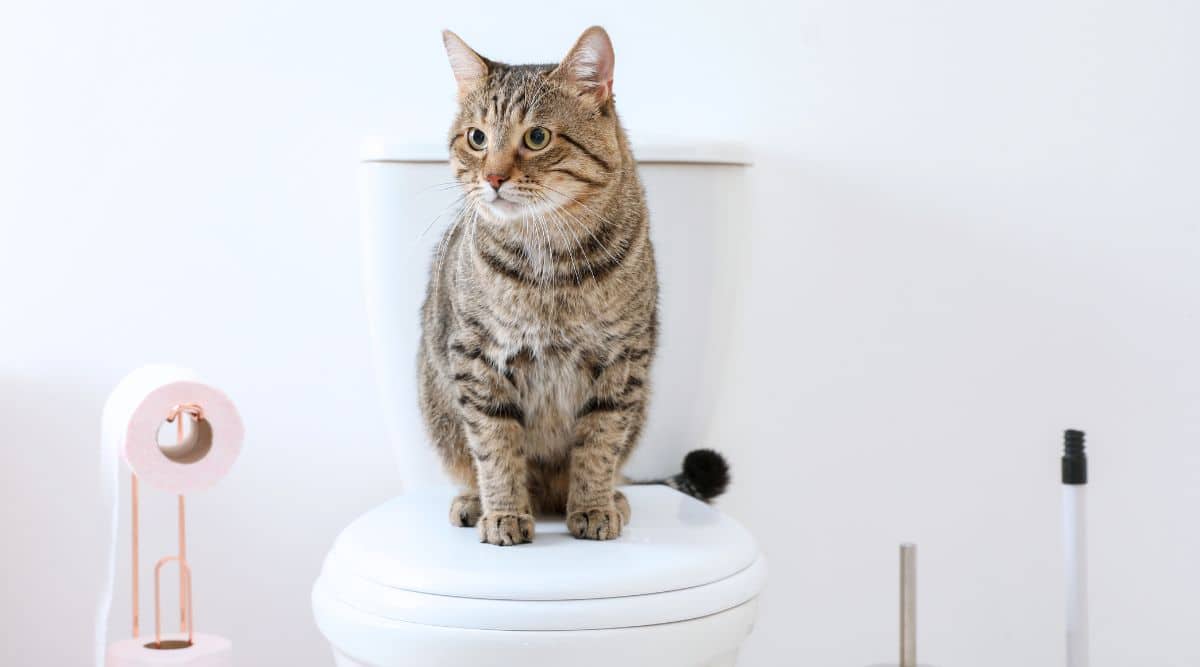My Dangers of Animal Waste in the Toilet
My Dangers of Animal Waste in the Toilet
Blog Article
We have unearthed this great article involving Don't Flush Your Pets Poo Down The Loo, Vet Warns listed below on the internet and accepted it made perfect sense to relate it with you over here.

When it pertains to dealing with waste, particularly animal waste, many individuals frequently consider the hassle-free option of flushing it down the toilet. Nonetheless, this relatively very easy solution can have significant effects for the setting and public health. In this post, we'll explore why flushing animal waste down the toilet is a poor idea and provide alternative techniques for proper disposal.
Introduction
Proper waste disposal is critical for preserving environmental sustainability and public health. While it may seem safe to purge animal waste down the bathroom, it can bring about different problems, both for the atmosphere and human health.
Risks of flushing pet waste
Environmental impact
Flushing pet waste presents dangerous germs and virus into waterways, which can negatively impact aquatic ecosystems. These virus can pollute water sources and harm aquatic life, interfering with fragile communities.
Public health worries
Pet waste contains dangerous microorganisms such as E. coli and Salmonella, which can posture major wellness risks to human beings. Purging animal waste down the bathroom can infect water products, bring about the spread of illness and infections.
Alternatives to flushing
Instead of purging animal waste down the commode, there are numerous alternate disposal techniques that are more environmentally friendly and hygienic.
Composting
Composting animal waste is an environment-friendly way to deal with it. By composting, raw material is broken down right into nutrient-rich soil, which can be made use of to fertilize gardens and plants.
Land fill disposal
Disposing of pet waste in a garbage dump is one more option. While not as eco-friendly as composting, it is a safer alternative to flushing, as it prevents the contamination of water resources.
Pet waste disposal systems
There are customized family pet waste disposal systems offered that safely and hygienically throw away animal waste. These systems usually use enzymes to break down waste and remove smells.
Actions to proper pet garbage disposal
To guarantee appropriate disposal of pet waste, follow these actions:
Scooping and bagging waste
Regularly scoop and bag animal waste utilizing biodegradable bags. This stops waste from polluting the setting.
Using assigned waste bins
Dispose of bagged animal waste in assigned waste bins, such as compost containers or landfill bins. Prevent flushing it down the commode in any way costs.
Cleansing litter boxes and family pet areas regularly
On a regular basis clean can and pet areas to avoid the accumulation of waste and bacteria. Usage pet-safe cleaning products to maintain hygiene.
Advantages of appropriate disposal approaches
Taking on proper disposal approaches for animal waste offers a number of benefits:
Reduced environmental pollution
Correct disposal techniques decrease the danger of environmental pollution, protecting rivers and ecological communities from contamination
Decreased danger of water contamination.
By preventing flushing pet waste down the toilet, the threat of water contamination is considerably decreased, guarding public health.
Enhanced hygiene and hygiene
Correct disposal techniques advertise far better hygiene and hygiene, developing a more secure atmosphere for both people and pets.
Verdict
In conclusion, flushing pet waste down the bathroom is hazardous to the atmosphere and public health. By taking on different disposal techniques and complying with appropriate waste administration practices, we can decrease the negative effect of animal waste and contribute to a cleaner, healthier world.
Why You Should Never Flush Cat Poop Down the Toilet
A rose by any other name might smell as sweet, but not all poop is created equal. Toilets, and our sewage systems, are designed for human excrement, not animal waste. It might seem like it couldn’t hurt to toss cat feces into the loo, but it’s not a good idea to flush cat poop in the toilet.
First and foremost, assuming your cat uses a litter box, any waste is going to have litter on it. And even the smallest amount of litter can wreak havoc on plumbing.
Over time, small amounts build up, filling up your septic system. Most litter sold today is clumping; it is made from a type of clay that hardens when it gets wet. Ever tried to scrape old clumps from the bottom of a litter box? You know just how cement-hard it can get!
Now imagine just a small clump of that stuck in your pipes. A simple de-clogger like Drano isn’t going to cut it. And that means it’s going to cost you big time to fix it.
For an amusing, graphic tale of what happens when you flush too much litter down the toilet all at once, take a few minutes to read Gene Weingarten’s 2017 Washington Post column “So that’s what happens when you flush cat litter down the toilet.”
Parasitic Contamination
Believe it or not, your healthy kitty may be harboring a nasty parasite. Only cats excrete Toxoplasma in their feces. Yet it rarely causes serious health issues in the cats that are infected. Most people will be fine too if infected. Only pregnant women and people with compromised immune systems are at risk. (If you’ve ever heard how women who are expecting are excused from litter cleaning duty, Toxoplasma is why.)
But other animals may have a problem if infected with the parasite. And human water treatment systems aren’t designed to handle it. As a result, the systems don’t remove the parasite before discharging wastewater into local waterways. Fish, shellfish, and other marine life — otters in particular — are susceptible to toxoplasma. If exposed, most will end up with brain damage and many will die.
Depending on the species of fish, they may end up on someone’s fish hook and, ultimately on someone’s dinner plate. If that someone has a chronic illness, they’re at risk.
Skip the Toilet Training
We know there are folks out there who like to toilet train their cats. And we give them props, it takes a lot of work. But thanks to the toxoplasma, it’s not a good idea.
Leave the toilet to the humans, and accept your future litter cleaning duty.

On a regular basis clean can and pet areas to avoid the accumulation of waste and bacteria. Usage pet-safe cleaning products to maintain hygiene.
Advantages of appropriate disposal approaches
Taking on proper disposal approaches for animal waste offers a number of benefits:
Reduced environmental pollution
Correct disposal techniques decrease the danger of environmental pollution, protecting rivers and ecological communities from contamination
Decreased danger of water contamination.
By preventing flushing pet waste down the toilet, the threat of water contamination is considerably decreased, guarding public health.
Enhanced hygiene and hygiene
Correct disposal techniques advertise far better hygiene and hygiene, developing a more secure atmosphere for both people and pets.
Verdict
In conclusion, flushing pet waste down the bathroom is hazardous to the atmosphere and public health. By taking on different disposal techniques and complying with appropriate waste administration practices, we can decrease the negative effect of animal waste and contribute to a cleaner, healthier world.
Why You Should Never Flush Cat Poop Down the Toilet
A rose by any other name might smell as sweet, but not all poop is created equal. Toilets, and our sewage systems, are designed for human excrement, not animal waste. It might seem like it couldn’t hurt to toss cat feces into the loo, but it’s not a good idea to flush cat poop in the toilet.
First and foremost, assuming your cat uses a litter box, any waste is going to have litter on it. And even the smallest amount of litter can wreak havoc on plumbing.
Over time, small amounts build up, filling up your septic system. Most litter sold today is clumping; it is made from a type of clay that hardens when it gets wet. Ever tried to scrape old clumps from the bottom of a litter box? You know just how cement-hard it can get!
Now imagine just a small clump of that stuck in your pipes. A simple de-clogger like Drano isn’t going to cut it. And that means it’s going to cost you big time to fix it.
For an amusing, graphic tale of what happens when you flush too much litter down the toilet all at once, take a few minutes to read Gene Weingarten’s 2017 Washington Post column “So that’s what happens when you flush cat litter down the toilet.”
Parasitic Contamination
Believe it or not, your healthy kitty may be harboring a nasty parasite. Only cats excrete Toxoplasma in their feces. Yet it rarely causes serious health issues in the cats that are infected. Most people will be fine too if infected. Only pregnant women and people with compromised immune systems are at risk. (If you’ve ever heard how women who are expecting are excused from litter cleaning duty, Toxoplasma is why.)
But other animals may have a problem if infected with the parasite. And human water treatment systems aren’t designed to handle it. As a result, the systems don’t remove the parasite before discharging wastewater into local waterways. Fish, shellfish, and other marine life — otters in particular — are susceptible to toxoplasma. If exposed, most will end up with brain damage and many will die.
Depending on the species of fish, they may end up on someone’s fish hook and, ultimately on someone’s dinner plate. If that someone has a chronic illness, they’re at risk.
Skip the Toilet Training
We know there are folks out there who like to toilet train their cats. And we give them props, it takes a lot of work. But thanks to the toxoplasma, it’s not a good idea.
Leave the toilet to the humans, and accept your future litter cleaning duty.

I am very focused on 4 Reasons Why Dog Poop Cleanup is Important and I really hope you enjoyed reading the new article. Do you know about another individual who is excited by 10 Things You Should Never Flush Down The Toilet? Take a moment to promote it. Thank you for being here. Revisit us soon.
Call Report this page